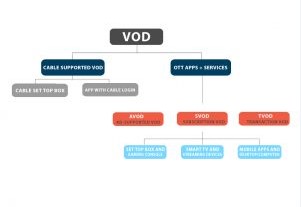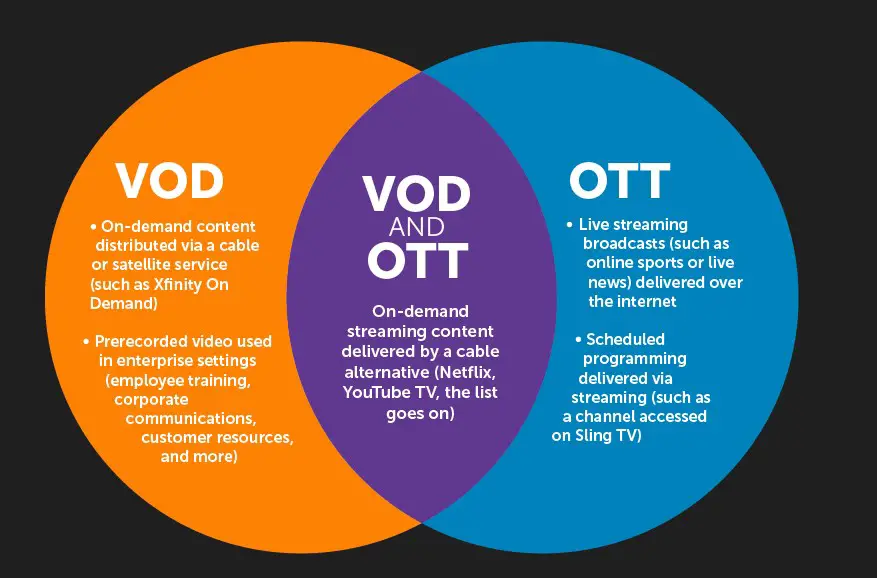OTT (Over-The-Top) and VOD (Video on Demand) are two common terms heard in the world of digital media and streaming. Both offer similar services, but there are some key differences you should be aware of when deciding which is the right choice for your streaming needs.
Key differences between ott and vod

OTT (over-the-top) and VOD (video-on-demand) services are both ways to watch content on demand, but there are key differences between the two. OTT services provide users access to content without the need for a cable or satellite TV subscription, while VOD services are usually part of a cable, satellite, or streaming provider’s package or offered as a standalone subscription. OTT services offer more flexibility and often have lower costs, while VOD services are more limited in terms of content offerings and are usually more expensive.
OTT services offer more flexibility and often have lower costs, while VOD services are more limited in terms of content offerings and are usually more expensive. Additionally, OTT services are typically more user-friendly, with better search and recommendation features, while VOD services can be more cumbersome to use. Ultimately, the differences between OTT and VOD services come down to the level of convenience and cost, so it’s important to consider both when choosing a streaming service.
Advantages of ott vs vod
OTT (Over-the-Top) and VOD (Video on Demand) are two different ways of delivering video content to consumers. OTT offers a wide range of content, including live streaming and on-demand services, while VOD is usually limited to on-demand content. While both methods provide access to video content, there are some key differences between the two.
While both methods provide access to video content, there are some key differences between the two. OTT is often more cost-effective and offers a greater range of content than VOD. It also allows for more personalized viewing experiences, as users can watch content when and where they choose.
Additionally, OTT services can be used on a wide variety of devices, from smartphones to TVs. On the other hand, VOD services are usually limited to just TVs, which can restrict the ability to watch content on the go. Ultimately, the decision between OTT and VOD comes down to user preference and budget.
Challenges of ott and vod
OTT (Over-the-top) and VOD (Video-on-Demand) have become increasingly popular ways for people to enjoy a variety of content. However, there are some key differences between these two services.
The main difference between the two is that OTT is more flexible and has fewer restrictions, while VOD is less flexible and has more restrictions. OTT also typically offers a wider range of content than VOD, as well as more customization options.
Additionally, OTT is generally cheaper than VOD services, allowing users to get more content for their money. On the other hand, VOD is often more reliable and offers more control over the content that is being watched, allowing users to pause, rewind, and fast-forward as they please. Ultimately, the choice between OTT and VOD depends on each individual’s needs and preferences.
Ultimately, the choice between OTT and VOD depends on each individual’s needs and preferences.
Factors to consider when choosing between ott and vod
When it comes to distributing your content, there are two main options to consider: Over-the-Top (OTT) and Video-on-Demand (VOD). OTT is a streaming media service that allows users to access content and services directly over the internet, without needing to rely on a traditional cable or satellite provider. VOD, on the other hand, is a type of service that allows users to access content on demand, typically with a pay-per-view model.
Both OTT and VOD offer viewers the flexibility and convenience of watching content when and where they want, but there are some key differences to consider when choosing between them. The primary difference between OTT and VOD is in the way content is delivered.
OTT relies on streaming media, which allows viewers to watch content in real-time, while VOD typically involves downloading a file that can be accessed at any time. This means that OTT content is generally available for viewing as soon as it is released, while VOD content may need to be downloaded before it can be watched. Additionally, OTT services typically have a wider range of content available than VOD services, as OTT services can stream both live and on-demand content.
Another key difference between OTT and VOD is cost. OTT services are often free or require a subscription fee, while VOD services typically require viewers to pay for each individual piece of content they want to access.
This can make VOD a more expensive option for viewers who want to watch a lot of content. Finally, one should consider the type of content they are looking for when deciding between OTT and VOD. OTT services typically offer movies, TV shows, and live sports, as well as other types of content, such as news and music. VOD services, on the other hand, are typically more focused on movies and TV shows, though some services do offer live content as well. When it comes to choosing between OTT and VOD, it’s important to consider the type of content you’re looking for, the cost of the service, and the way content is delivered. With these factors in mind, you can make an informed decision about which service is right for you.
Examples of ott and vod
OTT (Over the Top) and VOD (Video On Demand) are both forms of streaming content, but they have some key differences. OTT is usually subscription-based and offers a wide range of content and services, from streaming movies and TV shows to news and sports. On the other hand, VOD is more focused on providing users with access to a library of videos, usually on a pay-per-view basis.
On the other hand, VOD is more focused on providing users with access to a library of videos, usually on a pay-per-view basis. OTT services also tend to have more features, such as the ability to download content for offline viewing, while VOD services provide a more basic viewing experience. Ultimately, the choice between the two depends on what kind of streaming experience you’re looking for.
Bottom Line
In conclusion, there are several key differences between OTT and VOD. OTT is streamed over the internet, while VOD is typically accessed through cable or satellite services.
OTT is typically cheaper than VOD, and provides a more convenient viewing experience, as users can access content at any time. Ultimately, the decision between OTT and VOD depends on a user’s individual preferences and viewing habits.

